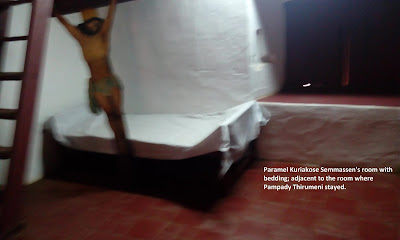 |
| His Grace Stephanos Mar Theodosius Metropolitan (of blessed memory) |
While study
at the English medium school, Punnai was elected the Secretary of the Literary Association.
That year on the anniversary day, a drama "Snapaka Yohannan," (John
the Baptist) was to be staged. The senior Malayalam teacher S. K. Nair was both
the director and one of the actors. He was a good orator and artist. He was to
take the role of Herodias and he compelled Punnai to act as Salome. Though Punnai
tried to avoid acting, S.K. Nair prevailed upon him to do so. Moreover, it was
compulsory for Punnai to act since he was the secretary of the Literary
Association.
Punnai was
scared to act in the drama since he knew Rambachan’s vehement opposition to
drama/cinema as he considered participating in drama was against the Christian
principles. Young Punnai
couldn’t tell SK Nair sir about his decision to become a priest and request him
to excuse him from acting as he had not even told his parents about his
priestly calling. The young lad reasoned to himself that Rambachan may not likely
know about the programme and since Rambachan himself had been a teacher it was
unlikely that he will get angry for a school programme.
Satisfied
with such reasonings, he acted in the drama. Among the main invitees was the
Very Rev. Alexandrios Cor-episcopa who was the father-in-law of the Rambachan’s
brother. Punnai assured himself that Cor-episcopa was quite advanced in his
years and may not recognize him.
The drama
was a great success. Rambachan was accompanied by the Cor-episcopa when Punnai
went to see him one day. On seeing Punnai, the Cor Episcopa told the Ramban about the
drama and that he (Punnai) acted the role of Salome very well. Punnai sweat
profusely-he was very much worried about the response of the Rambachan. Much to
his relief Rambachan only smiled and said no word of reprimand.
After a few
days S. K. Nair told Punnai that their drama was in great demand and that the
Headmaster of a High School in Kumarakam wanted it to be staged there on the
annual day. This time, Punnai told his teacher that he would participate in the
drama only if he got permission from the Rambachan.
Punnai went
to Rambachan to get permission who refused it outrightly saying, "don't participate
in any drama. It is not good for Christians."
Obeying his
spiritual guru, Punnai backed out and S. K. Nair found out a replacement for him.
The drama was staged, and it was as in the first time, a great success.
The teacher
and student met after almost thirty years after the above incident. The teacher
then was the head of the Malayalam department in the Madras University, a known
figure in Malayalam literary circle and a member of the Film Censor Board.
Meanwhile
the student climbed the spiritual ladder - becoming a deacon, then a priest and
finally a Metropolitan.
Vidwan S.
K. Nair become Dr. S. K. Nair and the young Punnai became His Grace Stephanos
Mar Theodosius.
When His
Grace visited Madras, he desired to meet his former teacher and an appointment
was arranged. As soon as Dr Nair saw Thirumeni, he bent down and touched the
feet of his former student. Thirumeni trying to stop him said- "Is it
not the student who should touch the feet of the teacher to get his
blessings? What will happen if it is in the other way?"
Dr. Nair replied,
"Then I was your teacher. Now you are Bishop, and people like you
are gurus to all."
While they
were talking Dr. S. K. Nair referred to the drama that they staged years ago at
the school in Kakuzhi. And guess
who was the replacement when the young Punnai backed out? It was none other
than Prem Nazir who later became one of the great actors in the world of cinema.!
Dr. S. K.
Nair continued, " I was confident that Your Grace would shine as an actor.
When I found a great actor in You, God found in You a great Priest. Everything
is the wish of God."
 |
| Actor Prem Nazir |
May the
prayers and intercessions of the saintly father- Mar Theodosius be our refuge always.
In Christ,
Rincy John
Ref: The Crown and the Gift- Stephanos Mar Theodosius
Saptati Publications, Publications Dept, Diocese of Calcutta, The Orthodox Church
of India, Bhilai, MP, India, 1994,
editor-Abraham Oommen, An Actor Incognito, Pgs 9-12












